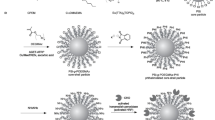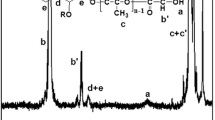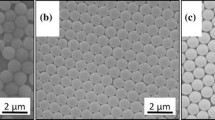Abstract
The paper presents a short review on the synthesis, characterisation and selected medical applications of poly(styrene/α-tert-butoxy-ω-vinylbenzyl-polyglycidol) (P(S/PGL)) microspheres. The soap-free emulsion-polymerisation of styrene and α-tert-butoxy-ω-vinylbenzyl-polyglycidol macromonomer (PGL) in water yielded core-shell microspheres with a low particle-diameter dispersity (ratio of the weight average particle diameter and the number average particle diameter). The interfacial fraction of PGL units, estimated by XPS, was in the range of 0–42 mole % depending on the concentration of the macromonomer in the polymerisation feed. The studies of adsorption of model proteins showed that the surface fraction of adsorbed protein was significantly reduced when the PGL interfacial fraction was higher than 40 mole %. The P(S/PGL) particles with covalently immobilised proteins were used for the preparation of photonic crystal assemblies suitable for applications in optical biosensors and the medical diagnostic test for the detection of Helicobacter pylori antibodies in the blood serum.
Similar content being viewed by others
References
Aizawa, H., Kurosawa, S., Tanaka, M., Wakida, S., Talib, Z. A., Park, J. W., Yoshimoto, M., Muratsugu, M., Hilborn, J., Miyake, J., & Tanaka, H. (2001). Conventional diagnosis of Treponema pallidum in serum using latex piezoelectric immunoassay. Materials Science and Engineering C, 17, 127–132. DOI: 10.1016/s0928-4931(01)00320-4.
Andersson, M., Hietala, S., Tenhu, H., & Maunu, S. L. (2006). Polystyrene latex particles coated with crosslinked poly(N-isopropylacrylamide). Colloid and Polymer Science, 284, 1255–1263. DOI: 10.1007/s00396-006-1470-2.
Arshady, R. (Ed.) (1999). Microspheres, microcapsules & liposomes (Vol. 1, Preparation and chemical applications). London, UK: Citus Books.
Arshady, R., Margel, S., Pichot, C., & Delair, T. (1999). Functionalization of preformed microspheres. In R. Arshady (Ed.), Microspheres, microcapsules & liposomes (Vol. 1, Chapter 6, pp. 165–196). London, UK: Citus Books.
Basinska, T. (2001). Adsorption studies of human serum albumin, human γ-globulins, and human fibrinogen on P(S/PGL) microspheres. Journal of Biomaterials Science, Polymer Edition, 12, 1359–1371. DOI: 10.1163/156856202753419277.
Basinska, T., Kergoat, L., Mangeney, C., Chehimi, M. M., & Slomkowski, S. (2007). Poly(styrene/α-tertbutoxy-ω-vinylbenzyl-polyglycidol) microspheres for the preparation of novel photonic crystals. e-Polymers, 087.
Basinska, T., Kowalczyk, D., Miksa, B., & Slomkowski, S. (1995). Interaction of proteins with polymeric latexes. Polymers for Advanced Technologies, 6, 526–533. DOI: 10.1002/pat.1995.220060714.
Basinska, T., & Slomkowski, S. (1995). Attachment of horseradish peroxidase (HRP) onto the poly(styrene/acrolein) latexes and onto their derivatives with amino groups on the surface; activity of immobilized enzyme. Colloid and Polymer Science, 273, 431–438. DOI: 10.1007/bf00656887.
Basinska, T., Slomkowski, S., & Delamar, M. (1993). Synthesis and characterization of polystyrene core/polyacrolein shell latexes. Journal of Bioactive and Compatible Polymers, 8, 205–219. DOI: 10.1177/088391159300800301.
Basinska, T., Slomkowski, S., Dworak, A., Panchev, I., & Chehimi, M. M. (2001). Synthesis and characterization of poly(styrene/α-t-butoxy-ω-vinylbenzyl-polyglycidol) microspheres. Colloid and Polymer Science, 279, 916–924. DOI: 10.1007/s003960100517.
Basinska, T., Slomkowski, S., Kazmierski, S., & Chehimi, M. M. (2008). Properties of poly(styrene/α-tert-butoxy-ω-vinylbenzyl-polyglycidol) microspheres suspended in water. Effect of sodium chloride and temperature on particle diameters and electrophoretic mobility. Langmuir, 24, 8465–8472. DOI: 10.1021/la800836t.
Basinska, T., Slomkowski, S., Kazmierski, S., Dworak, A., & Chehimi, M. M. (2004). Studies of the surface layer structure and properties of poly(styrene/α-t-butoxy-ω-polyglycidol) microspheres by carbon nuclear magnetic resonance, Xray photoelectron spectroscopy, and the adsorption of human serum albumin and γ-globulins. Journal of Polymer Science Part A: Polymer Chemistry, 42, 615–623. DOI: 10.1002/pola.10863.
Basinska, T., Wisniewska, M., & Chmiela, M. (2005). Principle of a new immunoassay based on electrophoretic mobility of poly(styrene/α-tert-butoxy-ω-vinylbenzyl-polyglycidol) microspheres: Application for the determination of Helicobacter pylori IgG in blood serum. Macromolecular Bioscience, 5, 70–77. DOI: 10.1002/mabi.200400112.
Búcsi, A., Forcada, J., Gibanel, S., Héroguez, V., Fontanille, M., & Gnanou, Y. (1998). Monodisperse polystyrene latex particles functionalized by the macromonomer technique. Macromolecules, 31, 2087–2097. DOI: 10.1021/ma971434q.
Caballero, M., Ruiz, R., Márquez de Prado, M., Seco, M., Borque, L., & Escanero, J. F. (1999). Development of microparticle-enhanced nephelometric immunoassay for quantitation of human lysozyme in pleural effusion and plasma. Journal of Clinical Laboratory Analysis, 13, 301–307. DOI: 10.1002/(SICI)1098-2825(1999)13:6〈301::AIDJCLA9t>3.0.CO;2-3.
Daly, E., & Saunders, B. R. (2000). A study of the effect of electrolyte on the swelling and stability of poly(Nisopropylacrylamide) microgel dispersions. Langmuir, 16, 5546–5552. DOI: 10.1021/la991292o.
DeSousaDelgado, A., Leonard, M., & Dellacherie, E. (2000). Surface modification of polystyrene nanoparticles using dextrans and dextran-POE copolymers: Polymer adsorption and colloidal characterization. Journal of Biomaterials Science, Polymer Edition, 11, 1395–1410. DOI: 10.1163/156856200744309.
Duracher, D., Elaïssari, A., Mallet, F., & Pichot, C. (2000). Adsorption of modified HIV-1 capsid p24 protein onto thermosensitive and cationic core-shell poly(styrene)-poly(N-isopropylacrylamide) particles. Langmuir, 16, 9002–9008. DOI: 10.1021/la0004045.
Dworak, A., Panchev, I., Trzebicka, B., & Walach, W. (1998). Poly(α-t-butoxy-ω-styrylo-glycidol): a new reactive surfactant. Polymer Bulletin, 40, 461–468. DOI: 10.1007/s002890050277.
Fitton, A. O., Hill, J., Jane, D. E., & Millar, R. (1987). Synthesis of simple oxetanes carrying reactive 2-substituents. Synthesis, 1987, 1140–1142. DOI: 10.1055/s-1987-28203.
Gam-Derouich, S., Gosecka, M., Lepinay, S., Turmine, M., Carbonnier, B., Basinska, T., Slomkowski, S., Millot, M. C., Othmane, A., Ben Hassen-Chehimi, D., & Chehimi, M. M. (2011). Highly hydrophilic surfaces from polyglycidol grafts with dual antifouling and specific protein recognition properties. Langmuir, 27, 9285–9294. DOI: 10.1021/la200290k.
Ganachaud, F., Sauzedde, F., Elaïssari, A., & Pichot, C. (1997). Emulsifier-free emulsion copolymerization of styrene with two different amino-containing cationic monomers. I. Kinetic studies. Journal of Applied Polymer Science, 65, 2315–2330. DOI: 10.1002/(SICI)1097-4628(19970919)65:12〈2315::AIDAPP6〉3.0.CO;2-C.
Gibanel, S., Heroguez, V., Gnanou, Y., Aramendia, E., Bucsi, A., & Forcada, J. (2001). Monodispersed polystyrene latex particles functionalized by the macromonomer technique. II. Application in immunodiagnosis. Polymers for Advanced Technologies, 12, 494–499. DOI: 10.1002/pat.108.
Gosecka, M., Griffete, N., Mangeney, C., Chehimi, M. M., Slomkowski, S., & Basinska, T. (2011). Preparation and optical properties of novel bioactive photonic crystals obtained from core-shell poly(styrene/α-tert-butoxy-ω-vinylbenzylpolyglycidol) microspheres. Colloid and Polymer Science, 289, 1511–1518. DOI: 10.1007/s00396-011-2447-3.
Green, R. J., Davies, M. C., Roberts, C. J., & Tendler, S. J. B. (1998). A surface plasmon resonance study of albumin adsorption to PEO-PPO-PEO triblock copolymers. Journal of Biomedical Materials Research, 42, 165–171. DOI: 10.1002/(SICI)1097-4636(199811)42:2〈165::AIDJBM1〉3.0.CO;2-N.
Griffete, N., Dybkowska, M., Glebocki, B., Basinska, T., Connan, C., Maître, A., Chehimi, M. M., Slomkowski, S., & Mangeney, C. (2010). Thermoresponsive colloidal crystals built from core-shell poly(styrene/α-tert-butoxy-ω-vinylbenzylpolyglycidol) microspheres. Langmuir, 26, 11550–11557. DOI: 10.1021/la100537v.
Halacheva, S., Rangelov, S., & Tsvetanov, C. (2006). Poly(glycidol)-based analogues to pluronic block copolymers. Synthesis and aqueous solution properties. Macromolecules, 39, 6845–6852. DOI: 10.1021/ma061040b.
Hazot, P., Delair, T., Elaïssari, A., Chapel, J. P., & Pichot, C. (2002). Functionalization of poly(N-ethylmethacrylamide) thermosensitive particles by phenylboronic acid. Colloid and Polymer Science, 280, 637–646. DOI: 10.1007/s00396-002-0664-5.
Heller, W., & Pangonis, W. J. (1957). Theoretical investigations on the light scattering of colloidal spheres. I. The specific turbidity. The Journal of Chemical Physics, 26, 498–506. DOI: 10.1063/1.1743332.
Hong, J., Hong, C. K., & Shim, S. E. (2007). Synthesis of polystyrene microspheres by dispersion polymerization using poly(vinyl alcohol) as a steric stabilizer in aqueous alcohol media. Colloids and Surfaces A: Physicochemical and Engineering Aspects, 302, 225–233. DOI: 10.1016/j.colsurfa.2007.02.027.
Imaz, A., Miranda, J. I., Ramos, J., & Forcada, J. (2008). Evidences of a hydrolysis process in the synthesis of Nvinylcaprolactambased microgels. European Polymer Journal, 44, 4002–4011. DOI: 10.1016/j.eurpolymj.2008.09.027.
Jamróz-Piegza, M., Utrata-Wesołek, A., Trzebicka, B., & Dworak, A. (2006). Hydrophobic modification of high molar mass polyglycidol to thermosensitive polymers. European Polymer Journal, 42, 2497–2506. DOI: 10.1016/j.eurpolymj.2006.04.017.
Kawaguchi, H., Sato, Y., Okumura, A., & Kyo, M. (2005). Enhancement of sensitivity and selectivity in surface plasmon resonance detection of a DNA point mutation by polymeric microspheres. e-Polymers, 050.
Kim, J. H., & Ballauff, M. (1999). The volume transition in thermosensitive core-shell latex particles containing charged groups. Colloid and Polymer Science, 277, 1210–1214. DOI: 10.1007/s003960050512.
Lacroix-Desmazes, P., & Guyot, A. (1996). Reactive surfactants in heterophase polymerization. 2. Maleate based poly(ethylene oxide) macromonomers as steric stabilizer precursors in the dispersion polymerization of styrene in ethanol-water media. Macromolecules, 29, 4508–4515. DOI: 10.1021/ma951849g.
López-León, T., Ortega-Vinuesa, J. L., Bastos-González, D., & Elaïssari, A. (2006). Cationic and anionic poly(N-isopropylacrylamide) based submicron gel particles: Electrokinetic properties and colloidal stability. The Journal of Physical Chemistry B, 110, 4629–4636. DOI: 10.1021/jp0540508.
Lowry, O. H., Rosenbrough, N. J., Farr, A. L., & Randall, R. J. (1951). Protein measurement with the Folin phenol reagent. Journal of Biological Chemistry, 193, 265–275.
Lucas, L. J., Chesler, J. N., & Yoon, J. Y. (2007). Lab-on-achip immunoassay for multiple antibodies using microsphere light scattering and quantum dot emission. Biosensors and Bioelectronics, 23, 675–681. DOI: 10.1016/j.bios.2007.08.004.
Ma, Q., Wang, X., Li, Y., Shi, Y., & Su, X. (2007). Multicolor quantum dot-encoded microspheres for the detection of biomolecules. Talanta, 72, 1446–1452. DOI: 10.1016/j.talanta.52007.01.058.
Miksa, B., Wilczynska, M., Cierniewski, C., Basinska, T., & Slomkowski, S. (1996). Composite poly(methyl methacrylatemethacrylic acid-2-hydroxyethyl methacrylate) latex for immunoassay. The case of plasminogen. Journal of Biomaterials Science, Polymer Edition, 7, 503–513. DOI: 10.1163/156856295x00562.
Okubo, M., Yamamoto, Y., & Kamei, S. (1989). XPS analysis (ESCA) of the surface composition of poly(styrene/2-hydroxyethyl methacrylate) microspheres produced by emulsifier-free emulsion polymerization. Colloid and Polymer Science, 267, 861–865. DOI: 10.1007/bf01410333.
Okumura, A., Sato, Y., Kyo, M., & Kawaguchi, H. (2005). Point mutation detection with the sandwich method employing hydrogel nanospheres by the surface plasmon resonance imaging technique. Analytical Biochemistry, 339, 328–337. DOI: 10.1016/j.ab.2005.01.017.
Omer-Mizrahi, M., & Margel, S. (2009). Synthesis and characterization of magnetic and non-magnetic core-shell polyepoxide micrometer-sized particles of narrow size distribution. Journal of Colloid and Interface Science, 329, 228–234. DOI: 10.1016/j.jcis.2008.09.047.
Ouali, L., Stoll, S., Pefferkorn, E., Elaissari, A., Lanet, V., Pichot, C., & Mandrand, B. (1995). Coagulation of antibodysensitized latexes in the presence of antigen. Polymers for Advanced Technologies, 6, 541–546. DOI: 10.1002/pat.1995.220060716.
Polpanich, D., Tangboriboonrat, P., Elaissari, A., & Udomsangpetch, R. (2007). Detection of malaria infection via latex agglutination assay. Analytical Chemistry, 79, 4690–4695. DOI: 10.1021/ac070502w.
Revilla, J., Elaïssari, A., Pichot, C., & Gallot, B. (1995). Surface functionalization of polystyrene latex particles with a liposaccharide monomer. Polymers for Advanced Technologies, 6, 455–464. DOI: 10.1002/pat.1995.220060706.
Rosen, S. L. (1993). Fundamental principles of polymeric materials (2nd ed.). New York, NY, USA: Wiley-Interscience.
Sajjadi, S. (2007). Nanoparticle formation by monomer-starved semibatch emulsion polymerization. Langmuir, 23, 1018–1024. DOI: 10.1021/la062397b.
Sanz Izquierdo, M. P., Martín-Molina, A., Ramos, J., Rus, A., Borque, L., Forcada, J., & Galisteo-González, F. (2004). Amino, chloromethyl and acetal-functionalized latex particles for immunoassays: a comparative study. Journal of Immunological Methods, 287, 159–167. DOI: 10.1016/j.jim.2004.01.020.
Slomkowski, S., Alemán, J. V., Gilbert, R. G., Hess, M., Horie, K., Jones, R. G., Kubisa, P., Meisel, I., Mormann, W., Penczek, S., & Stepto, R. F. T. (2011). Terminology of polymers and polymerization processes in dispersed systems (IUPAC Recommendations 2011). Pure and Applied Chemistry, 83, 2229–2259. DOI: 10.1351/pac-rec-10-06-03.
Slomkowski, S., & Basinska, T. (2010). Polymer nano- and microparticle based systems for medical diagnostics. Macromolecular Symposia, 295, 13–22. DOI: 10.1002/masy.200900084.
Slomkowski, S., Basinska, T., & Miksa, B. (2002). New types of microspheres and microsphere-related materials for medical diagnostics. Polymers for Advanced Technologies, 13, 906–918. DOI: 10.1002/pat.283.
Sofia, S. J., Premnath, V., & Merrill, E. W. (1998). Poly(ethylene oxide) grafted to silicon surfaces: Grafting density and protein adsorption. Macromolecules, 31, 5059–5070. DOI: 10.1021/ma971016l.
Soini, J. T., Waris, M. E., & Hänninen, P. E. (2004). Detection methods of microsphere based single-step bioaffinity and in vitro diagnostics assays. Journal of Pharmaceutical and Biomedical Analysis, 34, 753–760. DOI: 10.1016/s0731-7085(03)00562-4.
Takata, S., Shibayama, M., Sasabe, R., & Kawaguchi, H. (2003). Preparation and structure characterization of hairy nanoparticles consisting of hydrophobic core and thermosensitive hairs. Polymer, 44, 495–501. DOI: 10.1016/s0032-3861(02)00768-1.
Texter, J. (2003). Polymer colloids in photonic materials. Comptes Rendus Chimie, 6, 1425–1433. DOI: 10.1016/j.crci.2003.07.014.
Zhou, G., Veron, L., Elaissari, A., Delair, T., & Pichot, C. (2004). A new route for the preparation of cyano-containing poly(N-isopropylacrylamide) microgel latex for specific immobilization of antibodies. Polymer International, 53, 603–608. DOI: 10.1002/pi.1439.
Author information
Authors and Affiliations
Corresponding author
Rights and permissions
About this article
Cite this article
Basinska, T., Slomkowski, S. Design of polyglycidol-containing microspheres for biomedical applications. Chem. Pap. 66, 352–368 (2012). https://doi.org/10.2478/s11696-011-0122-2
Received:
Revised:
Accepted:
Published:
Issue Date:
DOI: https://doi.org/10.2478/s11696-011-0122-2




